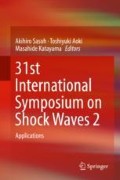Abstract
The effects of vibrational non-equilibrium and vibration–chemistry coupling on hydrogen–air detonation are numerically investigated by solving reactive Euler equations coupled with a multiple vibrational temperature-based model. Detailed hydrogen–air reaction kinetic is utilized, Landau–Teller model is adopted to solve the vibrational relaxation process, and the coupled vibration–chemistry vibration model is used to evaluate the vibration–chemistry coupling. It is shown that the relaxation process and vibration–chemistry coupling considerably influence the hydrogen–air detonation structure, highlighting the importance of correct treatment of vibrational non-equilibrium in detonation simulations.
Access this chapter
Tax calculation will be finalised at checkout
Purchases are for personal use only
References
M.J. Kaneshige, Gaseous Detonation Initiation and Stabilization by Hypervelocity Projectiles (California Institute of Technology, Pasadena, 1999)
N. Tsuboi et al., Three-dimensional numerical simulation for hydrogen/air detonation: Rectangular and diagonal structures. Proc. Combust. Inst. 29, 2 (2002)
V.N. Gamezo et al., Numerical simulations of flame propagation and DDT in obstructed channels filled with hydrogen–air mixture. Proc. Combust. Inst. 31, 2 (2007)
R. Millikan, D. White, Vibrational relaxation in air. AIAA J. 2, 10 (1964)
V. Komarov, Role of vibrational relaxation in the nonequilibrium flow of air in nozzles. J. Appl. Mech. Tech. Phys. 19, 2 (1978)
O. Knab et al., Theory and validation of the physically consistent coupled vibration-chemistry-vibration model. J. Thermophys. Heat Transf. 9, 2 (1995)
C. Park, Assessment of a two-temperature kinetic model for dissociating and weakly ionizing nitrogen. J. Thermophys. Heat Transf. 2, 1 (1988)
B. Taylor et al., Estimates of vibrational nonequilibrium time scales in hydrogen-air detonation waves, in 24th International Colloquium on the Dynamics of Explosive and Reactive Systems, Taipei, Taiwan, July 2013
S.-C. Chang, The method of space-time conservation element and solution element—A new approach for solving the Navier-Stokes and Euler equations. J. Comput. Phys. 119, 2 (1995)
H. Shen, C.-Y. Wen, A characteristic space–time conservation element and solution element method for conservation laws II. Multidimensional extension. J. Comput. Phys. 305, 775–792 (2016)
H. Shen et al., Robust high-order space–time conservative schemes for solving conservation laws on hybrid meshes. J. Comput. Phys. 281, 375–402 (2015)
H. Shen et al., A characteristic space–time conservation element and solution element method for conservation laws. J. Comput. Phys. 288, 101–118 (2015)
H. Shen et al., Maximum-principle-satisfying space-time conservation element and solution element scheme applied to compressible multifluids. J. Comput. Phys. 330, 668–692 (2017)
H. Shen, M. Parsani, The role of multidimensional instabilities in direct initiation of gaseous detonations in free space. J. Fluid Mech. 813, R4 (2017)
L. Shi et al., Assessment of vibrational non-equilibrium effect on detonation cell size. Combust. Sci. Technol. 189, 5 (2016)
M.P. Burke et al., Comprehensive H2/O2 kinetic model for high-pressure combustion. Int. J. Chem. Kinet. 44, 7 (2012)
R.J. Kee et al., CHEMKIN-III: A FORTRAN chemical kinetics package for the analysis of gas-phase chemical and plasma kinetics, Sandia national laboratories report SAND96-8216 (1996)
R.C. Millikan, D.R. White, Systematics of vibrational relaxation. J. Chem. Phys. 39, 12 (1963)
W.G. Vincenti, C.H. Kruger, Introduction to Physical Gas Dynamics (Krieger, Malabar, 1965), pp. 198–206
Z. Hong et al., A new shock tube study of the H + O 2 → OH + O reaction rate using tunable diode laser absorption of H 2 O near 2.5 μm. Proc. Combust. Inst. 33, 1 (2011)
M.F. Campbell et al., Dependence of calculated postshock thermodynamic variables on vibrational equilibrium and input uncertainty. J. Thermophys. Heat Transf. 31, 586–608 (2017)
Acknowledgment
We are grateful for the computing resources of the Supercomputing Laboratory and the Extreme Computing Research Center at King Abdullah University of Science and Technology. This research was supported by Hong Kong Innovation and Technology Commission (no. ITS/334/15FP) and Natural Science Foundation of China project, numbered 11372265.
Author information
Authors and Affiliations
Corresponding author
Editor information
Editors and Affiliations
Rights and permissions
Copyright information
© 2019 Springer Nature Switzerland AG
About this paper
Cite this paper
Shi, L.S., Zhang, P., Wen, C.Y., Shen, H., Parsani, M., Zhang, D.L. (2019). Numerical Study of Hydrogen–Air Detonation in Vibrational Non-equilibrium. In: Sasoh, A., Aoki, T., Katayama, M. (eds) 31st International Symposium on Shock Waves 2. ISSW 2017. Springer, Cham. https://doi.org/10.1007/978-3-319-91017-8_19
Download citation
DOI: https://doi.org/10.1007/978-3-319-91017-8_19
Published:
Publisher Name: Springer, Cham
Print ISBN: 978-3-319-91016-1
Online ISBN: 978-3-319-91017-8
eBook Packages: EngineeringEngineering (R0)

